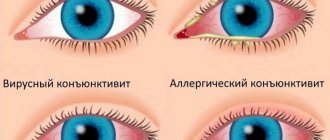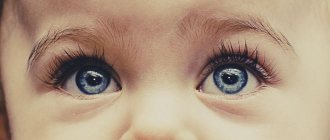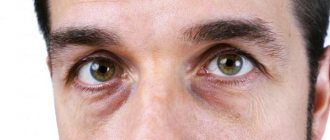And this is not at all difficult, because our skin is a litmus test for the chemical reactions occurring in the body. For example, with a cold, pimples or boils may appear on the skin, with liver disease in women, a certain pigmentation appears on the face, etc. In general, highly experienced diagnosticians who are able to tell almost everything about the patient’s state of health by looking at the iris of the eye and the skin around it.
Actually, it’s worth talking about the skin around the eyes. Usually, it is of a uniform color, one tone darker or lighter than the base color of the complexion. However, sometimes it can become thinner and red spots appear, which do not at all add a good mood to its owner.
Let's look at the most common causes of red spots around the eyes.
- Kidneys. Existing stones, kidney failure or any other problems with this organ can be reflected on the skin in the form of swelling, bags, redness or darkening (the skin around the eyes darkens).
- Lack of sleep, nervous breakdowns, stress. A simple example: a couple of days without sleep, active brain activity, tension, a lot of coffee and redness of the eyes, as well as the skin around them, is guaranteed.
- Dermatological problems. Of course, the skin around the eyes is less susceptible to skin diseases, but the occurrence of dermatitis or eczema cannot be completely ruled out. In this case, not only redness occurs, the skin may begin to peel, flake, and become crusty.
- Acute inflammation (abscess or phlegmon). The intervention of a doctor in this case is vital.
- Allergic manifestations. They are often accompanied by skin rashes, which is a reaction to exposure to an allergen: pollen, household dust, animal hair, etc.
- Congenital skin abnormalities. For example, age spots. They are often localized on the face in close proximity to the eyes.
- Unhealthy Lifestyle. Little physical activity, lack of air, poor nutrition, bad habits, etc.
Symptoms
Of course, it is simply impossible to note all the symptoms in order to make a diagnosis yourself. However, some pronounced diseases have quite memorable manifestations. So.
- Seborrheic dermatitis. It is accompanied by peeling and redness in the area under the lower eyelid, as well as under the eyebrows.
- Allergy. Its characteristic manifestation is itching, which quickly disappears after taking antihistamines.
- Sensitive skin. True, this is not a symptom, but rather a statement. It is with sensitive skin that redness around the eyes may occur due to the scorching sun, etc.
- In case of renal failure, the resulting spot does not hurt, but is slightly swollen. Moreover, such a problem is necessarily accompanied by at least a small amount of swelling.
However, this is not a complete list of symptoms that are expressed in redness of the area around the eyes.
Why spots appear and additional symptoms
Conjunctivitis
This disease is the most common reason why red dots appear on the eyelids. The disease is an inflammation of the mucous membrane of the organs of vision. Pathology can be caused by allergic reactions or viral and bacterial infections. In this case, patients complain of increased secretion of tears, and sometimes purulent discharge may be observed from the eyes. In addition, the following symptoms occur:
- swelling and redness of the mucous membrane of the organs of the visual system;
- itching and burning of the eyes;
- feeling of a foreign body in the organ of vision;
- photophobia;
- difficulty opening the eyelids after waking up due to their gluing with secretions;
- deterioration of visual functions.
Allergic dermatitis
Redness and peeling of the skin around the eyes may be associated with an allergic reaction of the body, for example in women, to low-quality cosmetics.
Mostly occurs due to infection or exposure to chemicals. When the pathogen comes into contact with the epidermis, it provokes a serious allergic reaction. Often representatives of the fair sex suffer from allergic dermatitis due to the use of low-quality cosmetics and hair dyes. However, not only women, but also men are susceptible to pathology. It is possible that allergic dermatitis may occur in a child. Red dots under and above the eyes can occur due to so-called drug dermatitis. Its formation is due to the use of a large amount of medications. In addition to the appearance of red spots, the following signs are also observed:
- itching and burning of the eyes;
- the presence of bubbles on the skin, inside of which there is a clear liquid;
- the appearance of small ulcers;
- swelling of the lower eyelid;
- difficulty blinking.
Eczema and red spots
If a dark spot appears on the eyelids, the possibility of eczema cannot be ruled out. This pathology can be provoked by household dust, pollen, the use of certain medications, as well as hormonal imbalance. The following symptoms are characteristic of this disease:
Eczema is accompanied by unpleasant symptoms such as severe itching and swelling of the eyelids.
- constant itching of the skin;
- small red spots that are very itchy and flaky;
- swelling;
- discomfort when touched.
Dysbacteriosis
If the balance of pathogenic and beneficial microflora of the gastrointestinal tract is disturbed, you can often notice a convex spot on the inner or outer side of the organ of vision. Dysbacteriosis can be provoked by prolonged therapy with antibacterial drugs, cancer, and AIDS. In addition to the appearance of red spots, patients experience the following symptoms:
- diarrhea;
- discomfort in the stomach area;
- weight loss.
Demodectic mange and red spots
It is a lesion of the skin by a subcutaneous mite called Demodex. According to numerous studies, these parasites are present on the epidermis of almost all healthy people, however, the development of the disease is observed when there are disruptions in hormonal levels, disruption of the functioning of the immune and endocrine systems. In addition, constant stress, various chronic diseases that worsen metabolism, as well as systematic exposure to public baths and saunas also contribute to infection. The following signs are characteristic of demodicosis:
The appearance of pustules and redness around the eyes indicates the development of demodicosis, which is caused by a subcutaneous mite.
- swelling of the upper and lower eyelids;
- the appearance of red spots;
- itching and burning;
- eyelash loss;
- pustules;
- peeling of the skin of the eyelids;
- inflammatory processes of the mucous membrane of the eye;
- rapid fatigue of the visual organs.
Hemangioma
The red dot is a tumor-like formation that is benign in nature. Despite this, some hemangiomas are still dangerous because they can grow rapidly, causing a functional defect. At the beginning of the development of the neoplasm, a small swelling appears in the eye area and a change in the color of the skin of the eyelids is observed. When touched, a person complains of discomfort. As it progresses, the hemangioma often grows, resulting in disruption of the functioning of the eyelids.
Pathology also brings cosmetic discomfort.
Treatment
It is worth remembering that eliminating the cause that caused the redness will automatically eliminate the effect. Therefore, it is very important to find out the essence of the issue.
Seborrheic dermatitis is characterized by itching, peeling and focal redness of the skin. When it is caused by an allergy, the basis of therapy will be the use of antihistamines, as well as the use of corticosteroid ointments - Flucenar or Lorinden.
Abscess A very serious condition that requires immediate medical attention. In this case, you need to see a doctor as quickly as possible. An abscess is a pathological process accompanied by tissue death. Therefore, it is simply necessary to support the skin. However, the decision on adequate treatment can only be made by a doctor.
Features of the skin When red spots are a physiological feature inherent in your skin, there is nothing to worry about. Today there are many different cosmetics that will eliminate such a defect.
Clinical symptoms
The appearance of formations in the eyes is accompanied by itching of the skin, as toxins accumulate in the body.
Red, brown, yellow or white spots on the upper eyelid are accompanied by the following symptoms:
- Skin itching. The skin can itch not only on the face, but throughout the body. This indicates the accumulation of toxins in the body.
- Hepatomegaly. This term refers to enlargement of the liver when it is inflamed.
- Noise in the ears, flickering of flies before the eyes. They are accompanied by the atherosclerotic process in the vascular walls of the brain.
- Shortness of breath and feeling of lack of air. They indicate heart failure due to atherosclerosis of the coronary vessels.
- Arthralgia. Joint pain accompanies many autoimmune processes, so it can coincide with facial rashes.
- Blueness of the distal parts of the body. Most often, cyanosis appears in the area of the nasolabial triangle and fingertips.
- Headache. Observed in arterial hypertension due to atherosclerosis, in some autoimmune diseases and inflammatory processes in various organs.
Folk remedies
In the fight for beauty, all means are good. In addition, there are a number of products that can improve the condition of the skin that are always at hand. One way that always works is masks. They make them from literally everything.
1. Potatoes. For masks, it is rubbed on a fine grater and the resulting paste is applied to the eye area using cotton swabs for 2 or 3 minutes. The healing properties of potatoes have not yet been fully studied, but the fact that it has a beneficial effect on the skin is undeniable. 2. Dill seeds. For the mask, these seeds are poured into a small fabric bag and placed in fairly hot water. Take out the bag after a few minutes, squeeze it out and apply it to your eyes for 5 minutes. 3. Herbs. Decoctions of cornflower and string are considered especially effective.
Features of chalazion on the lower eyelid
Unlike a pea in the upper eyelid, a chalazion of the lower eyelid in a child or adult proceeds more slowly and the symptoms are less pronounced. A distinctive feature is that the inflamed grain can spontaneously disappear, but only for a while. Once a pea appears inside the lower eyelid, it may take at least 2 weeks for other symptoms to appear. Due to the fact that the pea forms inside the eyelid, it grows towards the eyeball. And this is fraught with deterioration in visual acuity and the sensation of a foreign body. In addition, an infection may occur and other ophthalmological pathology may develop. For example, keratitis, conjunctivitis, etc.
Prevention
As a rule, treatment is not required when adequate disease prevention has been established. To prevent red spots from appearing in the eye area, it is necessary to act comprehensively: make it a rule to lead a healthy lifestyle, organize yourself proper rest, as well as sleep.
It is also necessary to strengthen the body’s immune system, for which it is worth taking the necessary vitamins and minerals. Reduce mental and visual stress, walk more often. Which will lead to the disappearance of symptoms and red spots will no longer be a serious problem for you.
Causes of chalazion of the lower eyelid
Blockage of the sebaceous glands occurs due to the following unfavorable factors:
- Wearing contact lenses and improper hygienic care for them.
- Hormonal imbalance.
- Untreated stye and weakened immune system.
- Diabetes mellitus and the use of low-quality cosmetics.
- Contact with sick people and failure to comply with basic hygiene rules.
- Colds and hypothermia.
- Nervous tension, stress.
- Vitamin deficiency and lack of nutrients in the body.
- Dysbacteriosis, gastritis and other diseases of the gastrointestinal tract.
- Infection around the eye skin.
- Eye diseases. In this case, the chalazion of the lower eyelid acts as a symptom.
Our advantages
"Moscow Eye Clinic" offers comprehensive diagnostics and effective treatment of eye diseases. The use of the most modern equipment and the high professional level of specialists working in the clinic eliminate the possibility of diagnostic errors.
Based on the results of the examination, each visitor will be given recommendations on choosing the most effective methods of treating the eye pathologies identified in them. By contacting the Moscow Eye Clinic, you can be sure of quick and accurate diagnosis and effective treatment.
All questions you are interested in can be asked to specialists by calling 8 (800) 777-38-81 and 8 (499) 322-36-36 or online using the appropriate form on the website.
Mironova Irina Sergeevna
Symptoms of chalazion of the lower eyelid
- Tumor formation in the inner part of the lower eyelid. It manifests itself as a slight compaction, which may disappear for a while.
- Redness of the mucous membranes and slight swelling.
- Pain when pressing on the tumor.
- Increased lacrimation and foreign body sensation.
- Itching and pain.
- Decreased visual acuity.
- Formation of purulent fluid.
- The inner side of the eyelid is covered with a red or grayish stain.
- Splitting of objects.
- Infection of other elements of the visual organ.
- Deformation of the lower eyelid.
IMPORTANT! With a chalazion of the lower eyelid, the symptoms appear gradually; in the first weeks there is only a slightly noticeable pea in the form of a slight compaction. And only after time has passed, other manifestations begin. For this reason, the disease is often diagnosed only in late stages, which makes drug treatment of lower eyelid chalazion ineffective.
Chalazion of the lower eyelid – photo:
Causes of peeling eyelids
The most common factors that can be used to explain why the skin on the eyelids peels are:
- allergies or irritation of the epidermis caused by the use of low-quality or expired eye cosmetics,
- seasonal allergies,
- age factor (so-called dry eye syndrome),
- respiratory diseases,
- dry skin,
- hard or chlorinated water,
- contact lenses that were not selected in accordance with all standards, or were stored incorrectly,
- too dry air in the room, where most often there is a person who experiences redness and peeling of the upper eyelid (one or both),
- eye fatigue,
- bad habit of constantly scratching your eyes,
- sitting at a computer screen for long periods of time,
- using aggressive products to wash or cleanse the skin of the face.
In addition to these factors, peeling and redness of the eyelids can be the result of a foreign object getting into the eyes. In this case, the person will also experience tearing, itching and burning of the eyes. Such irritation of the mucous membrane of the visual organ cannot but affect the condition of the skin of the eyelids.
If the cause of this phenomenon is not associated with serious diseases, then peeling of the skin on the eyelids will go away on its own in a few days. However, if there is any pathology, you should consult a doctor for advice. A thorough examination and modern diagnostic methods will help determine the exact cause of the anomaly.
Pathologies that can lead to peeling of the upper eyelid are:
- Demodicosis, the development of which is caused by hair mites. It can also be diagnosed at home. So, with this disease, the patient experiences redness and flaking on the eyelids, foamy liquid is released from the eyes, and itching and burning are felt. Eyelash loss, increased lacrimation and severe redness of the whites of the eyes are possible.
- Blepharitis. Pathology often develops in people with a weak immune system, as well as with chronic conjunctivitis, vitamin deficiency, and gastrointestinal diseases. Symptoms of the disease can manifest themselves as peeling of the skin of the eyelids, heaviness in the eyes, photophobia, swelling and hyperemia of the eyelids. When the eyelids begin to peel intensely, eyelash loss occurs. There is no need to hesitate: blepharitis is a dangerous disease that can become chronic.
- Conjunctivitis is an eye disease in which there is redness of the whites of the eyes, itching and the presence of purulent discharge. The eyes become swollen and photophobia appears. If the issue of treatment is not addressed in time, the patient’s eyelid skin will begin to peel, not only the upper, but also the lower.
- Barley. This pathology can develop against the background of incompletely cured or often recurrent conjunctivitis. It manifests itself through redness of the eyes and the formation of a lump with pathological contents on the surface of the eyelid (or on its mucous membrane). If the eyelid is peeling, watery eyes and a headache appear, rest assured that your fears are correct – it’s a stye.
- Fungal infections. If the skin on the eyelids is red and peeling, especially in areas where there is hair, the cause of the abnormality may be a yeast fungus. The manifestations of the disease cannot be ignored, as it can be transmitted to others.
- Hormonal imbalance. This pathology can manifest itself in different ways. If, due to an allergy, red spots appear on the eyelids that itch and flake, then with a hormonal imbalance, only the rejection of dead cells of the epidermis is observed. This phenomenon is also not considered normal, but you should not take hormonal medications at your own discretion - leave the choice of medication to a qualified physician so as not to harm yourself.
- Herpes virus infection is another common reason why the skin on the upper eyelid peels. In this case, the epidermis becomes dry and red, and the patient develops blisters on the surface of the eyelids filled with infected fluid. They lead to itching, burning, and painful sensations.
It is extremely rare that the skin on the eyelids peels and itches, indicating the presence of:
- diabetes mellitus type 2,
- liver dysfunction,
- gastrointestinal diseases.
If you cannot independently identify the causes of dry eyelid skin and its peeling, this can only mean that some pathological processes are occurring in the body. The sooner they can be detected, the less dangerous and unpleasant the consequences for human health will be.
What to do if the eyelid is swollen, red and itchy? What measures to take?
Only an ophthalmologist can determine the root cause and then tell you how to properly treat swelling after collecting an anamnesis, examining the eye and laboratory tests. If necessary, the ophthalmologist prescribes examination by other specialists. For example, in case of kidney or heart problems. If the lower eyelid is red and itchy due to allergies, then antihistamines are first prescribed. Additionally, ointments based on corticosteroids can be used. For example, hydrocortisone. The main reasons why the eye and lower eyelid become itchy and red are infections. They are most often introduced due to non-compliance with personal hygiene rules. In this case, the result will almost always be swelling and swelling of the eyelid. If an infectious process develops, it is recommended to use Albucid or Levomycetin drops.
When eye swelling is accompanied by a severe inflammatory process, the ophthalmologist has the right to prescribe erythromycin ointment and the drug “Ofloxacin”. These medications are aimed at ensuring that the swelling goes down and the eye stops itching.
Causes of diseases
Chalazion can occur for various reasons, namely:
- as a consequence of untreated barley;
- with increased sebum secretion for some reason (increased oily skin, hormonal changes)
- as a consequence for diseases such as seborrheic dermatitis, chronic blepharitis, rosacea, diabetes mellitus;
- with dysfunction of the biliary tract and gastrointestinal tract;
- in frequently recurring stressful situations;
- with hypothermia, ARVI, weakened immunity;
- failure to maintain personal hygiene (infection in the eyes with dirty hands, careless use of lenses).










